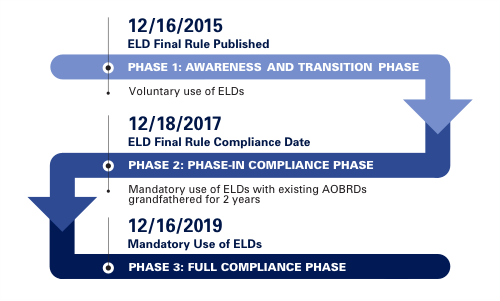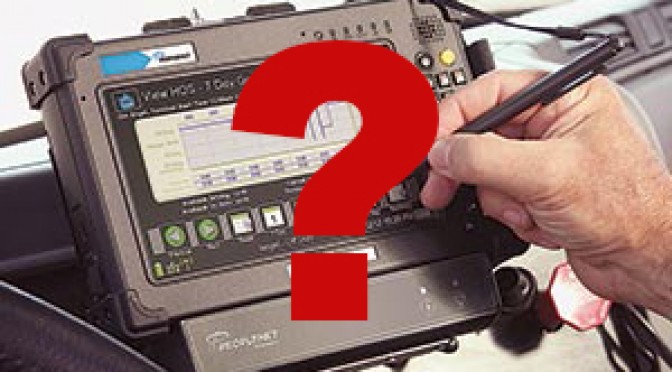Do I Need an ELD?
According to the FMCSA website, the electronic logging device (ELD) rule – congressionally mandated as a part of MAP-21 – is intended to help create a safer work environment for drivers, and make it easier and faster to accurately track, manage, and share records of duty status (RODS) data. An ELD synchronizes with a vehicle engine to automatically record driving time, for easier, more accurate hours of service (HOS) recording.
The ELD rule creates standard data displays and data transfer processes, making it easier to demonstrate compliance and faster to share RODS with safety officials. The rule does not change any of the basic hours-of-service rules or exceptions.
Who must comply?
The ELD rule applies to most motor carriers and drivers currently required to prepare and retain paper RODS to comply with the HOS regulations under part 395. The rule applies to commercial buses as well as trucks. Canada- and Mexico-domiciled drivers are included, unless they qualify for one of the exceptions to the ELD rule.
Drivers must understand and be able to use ELDs by the required deadline, including how to annotate and edit RODS, certify RODS, and collect required supporting documents. You will also need to know how to display and transfer data to safety officials when requested.
Comply now with best-in-class ELD/Telematics provider, Geotab. Learn more about Geotab and GeoDrive ELD.
Who are exempt?
- - Drivers who use paper logs no more than 8 days during any 30-day period.
- - Drivers who conduct driveaway - towaway operations, where vehicle being driven is the commodity being delivered (i.e. transporting an empty vehicle for sale, lease or repair)
- - Drivers of vehicles engines manufactured before model year 2000.
- - Short haul (100/150 air mile radius) exemption |Those drivers who are not required to maintain RODS because they operate under the short haul/ 100-air mile exemption, may continue without adopting ELDs. However, if the driver exceeds the conditions of the exemption rule for more than 8 days in any 30 day period, those drivers will be required to adopt ELDs.
- - Truck Renting and Leasing Association (TRALA) | Expires: October 11, 2022 This limited exemption provides that all drivers of property-carrying commercial motor vehicles (CMVs) rented for 8 days or less, regardless of reason, are not required to use an ELD in the vehicle. While operating under this exemption, drivers will remain subject to the standard hours-of-service (HOS) limits, maintain a paper record of duty status (RODS) if required, and maintain a copy of the rental agreement on the vehicle.
- - United Parcel Service | Expires: October 20, 2022
- - Motion Picture Association of America | Expires: January 19, 2023 This is a limited exemption for all commercial motor vehicle (CMV) drivers providing transportation to or from a theatrical or television motion picture production site. MPAA requested this exemption to allow these drivers to complete paper records of duty status (RODS) instead of using an ELD device.
- - Transportation of Agricultural Commodities | Expires: June 18, 2018 This is a limited 90-day exemption for the transportation of agricultural commodities as defined in the Federal Motor Carrier Safety Regulations (FMCSRs).
When does it apply?
Drivers must transition to using compliant ELDs by December 2017 unless they have automatic on-board recording devices (AOBRDs) that are grandfathered under this rule. This means that drivers using AOBRDs must also transition to using compliant ELDs, but they will have an additional two years to do so (until December 2019).

What are the key technical features of an ELD?
The Final Rule sets out details of the technical standards and functional specifications for an ELD to be considered compliant and eligible for self-certification and registration on the FMCSA website.
The ELD must support:
- - Automatic capture of records at certain intervals from connecting to the vehicle: e.g. date, time, location, engine power status, engine hours, miles driven and motion status
- - Personal Use and Yard Use to be recorded as off-duty time if carrier authorizes the vehicle to be used for such use.
- - Annotations and edits to ELD records to be permissible for drivers and carriers. However, original records cannot be overwritten and must be retained along with the edited versions.
- - Detection of malfunctions with internal audit controls built into the system to notify data inconsistencies and system failures.
- - Data transfer to enforcement officials upon request using either a wireless web service or email, and Bluetooth or USB.
- - Driver HOS Graph Grid display to be available for the enforcement official without entering the vehicle, as backup to data transfer capability.
We don't care what ELD you use! Learn how to optimize your ELD with Glostone.
Key questions to ask for finding the best-fit ELD for your company:
- - How should I manage the transition?
- - Is the solution simple and intuitive for my drivers?
- - Will it be easy to train my drivers and staff?
- - Will I be compliant using it now and in the future?
- - Will I have the right support from my technology provider?
- - Will the solution meet my operational needs?
- - Owner operators with personal use
- - Yard use
- - Easy installation for my lease vehicles
- - Team driving
- - Multiple terminals
- - Outsourcing back office administration
- - Can I leverage the solution for other value added services?
- - Fleet management and real time tracking
- - Commercial reporting on fuel, idle, speed and geofences
- - Electronic tax reporting and filing for IFTA and WMT
- - DVIR, vehicle service and maintenance management

